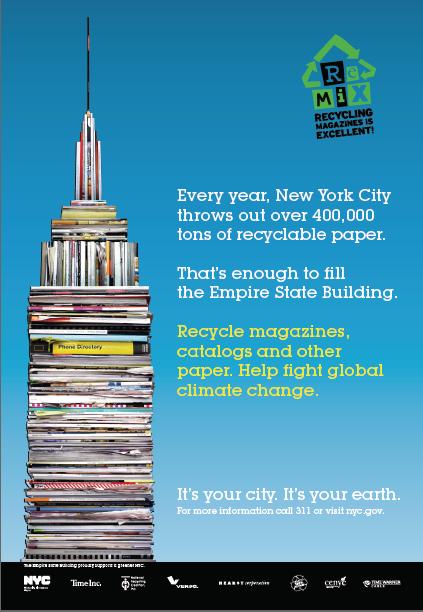 Mayor Bloomberg Launches REMIX: Recycling Magazines is Excellent!
Mayor Bloomberg Launches REMIX: Recycling Magazines is Excellent! Mayor Michael R. Bloomberg today announced the New York City launch of ReMix - Recycling Magazines is Excellent! - a national public education campaign aimed at increasing residential recycling of magazines and catalogs.
ReMix promotions will appear across New York City, in full-page public service advertisements in consumer magazines including TIME, Cosmopolitan, Country Living and Sports Illustrated as well as on buses and subways, in movie theatres, on cable television, and in other outlets. The total value of paid placements and in-kind donations for the ReMix campaign will top $3 million. The ReMix national campaign was started by Time Inc., with partners Verso Paper and the National Recycling Coalition.
"To meet the ambitious goals in our landmark Solid Waste Management Plan (SWMP), we need to increase recycling rates, and we know we can do a better job recycling magazines and catalogs," said Mayor Bloomberg. "Many New Yorkers don't realize that magazines, catalogs, phone books, and other kinds of paper are just as recyclable as newspapers and office paper. I'd like to thank our ReMix campaign partners for doing their part to increase magazine and catalog recycling and for joining our effort to build a greener, greater New York."The ReMix campaign began when a study by Time Inc. and Verso Paper found that while 95 percent of all unsold newsstand magazines are recycled by newsstands and publishers, only about 17 percent of sold magazines are recycled.
"Our national research showed that Americans support recycling, but are often uncertain about what can be recycled," said National Recycling Coalition Executive Director Kate Krebs. "We know that New Yorkers have embraced recycling as a way to keep waste out of landfills and improve the environment. Today, the Mayor and City officials, leading companies and advocacy organizations are launching ReMix in New York City to make sure everyone knows just how easy it is to recycle magazines and catalogs right along with their other paper recycling."
Partners:
Time Inc.
Verso Paper
National Recycling Coalition
Hearst Corporation
Pratt Industries
Time Warner Cable
The Council on the Environment of New York City




